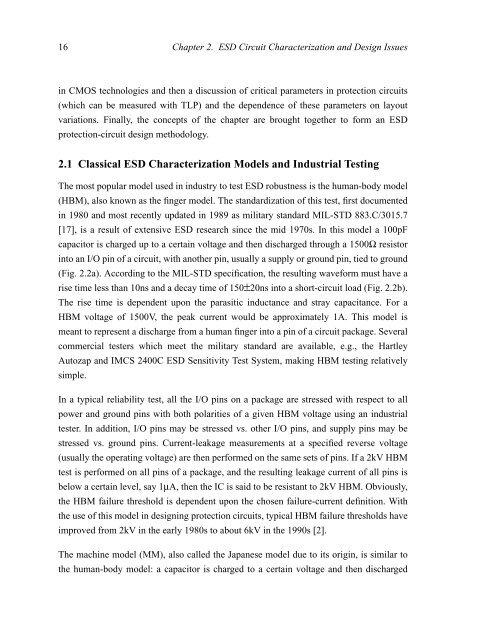characterization, modeling, and design of esd protection circuits
characterization, modeling, and design of esd protection circuits
characterization, modeling, and design of esd protection circuits
You also want an ePaper? Increase the reach of your titles
YUMPU automatically turns print PDFs into web optimized ePapers that Google loves.
16 Chapter 2. ESD Circuit Characterization <strong>and</strong> Design Issues<br />
in CMOS technologies <strong>and</strong> then a discussion <strong>of</strong> critical parameters in <strong>protection</strong> <strong>circuits</strong><br />
(which can be measured with TLP) <strong>and</strong> the dependence <strong>of</strong> these parameters on layout<br />
variations. Finally, the concepts <strong>of</strong> the chapter are brought together to form an ESD<br />
<strong>protection</strong>-circuit <strong>design</strong> methodology.<br />
2.1 Classical ESD Characterization Models <strong>and</strong> Industrial Testing<br />
The most popular model used in industry to test ESD robustness is the human-body model<br />
(HBM), also known as the finger model. The st<strong>and</strong>ardization <strong>of</strong> this test, first documented<br />
in 1980 <strong>and</strong> most recently updated in 1989 as military st<strong>and</strong>ard MIL-STD 883.C/3015.7<br />
[17], is a result <strong>of</strong> extensive ESD research since the mid 1970s. In this model a 100pF<br />
capacitor is charged up to a certain voltage <strong>and</strong> then discharged through a 1500Ω resistor<br />
into an I/O pin <strong>of</strong> a circuit, with another pin, usually a supply or ground pin, tied to ground<br />
(Fig. 2.2a). According to the MIL-STD specification, the resulting waveform must have a<br />
rise time less than 10ns <strong>and</strong> a decay time <strong>of</strong> 150±20ns into a short-circuit load (Fig. 2.2b).<br />
The rise time is dependent upon the parasitic inductance <strong>and</strong> stray capacitance. For a<br />
HBM voltage <strong>of</strong> 1500V, the peak current would be approximately 1A. This model is<br />
meant to represent a discharge from a human finger into a pin <strong>of</strong> a circuit package. Several<br />
commercial testers which meet the military st<strong>and</strong>ard are available, e.g., the Hartley<br />
Autozap <strong>and</strong> IMCS 2400C ESD Sensitivity Test System, making HBM testing relatively<br />
simple.<br />
In a typical reliability test, all the I/O pins on a package are stressed with respect to all<br />
power <strong>and</strong> ground pins with both polarities <strong>of</strong> a given HBM voltage using an industrial<br />
tester. In addition, I/O pins may be stressed vs. other I/O pins, <strong>and</strong> supply pins may be<br />
stressed vs. ground pins. Current-leakage measurements at a specified reverse voltage<br />
(usually the operating voltage) are then performed on the same sets <strong>of</strong> pins. If a 2kV HBM<br />
test is performed on all pins <strong>of</strong> a package, <strong>and</strong> the resulting leakage current <strong>of</strong> all pins is<br />
below a certain level, say 1µA, then the IC is said to be resistant to 2kV HBM. Obviously,<br />
the HBM failure threshold is dependent upon the chosen failure-current definition. With<br />
the use <strong>of</strong> this model in <strong>design</strong>ing <strong>protection</strong> <strong>circuits</strong>, typical HBM failure thresholds have<br />
improved from 2kV in the early 1980s to about 6kV in the 1990s [2].<br />
The machine model (MM), also called the Japanese model due to its origin, is similar to<br />
the human-body model: a capacitor is charged to a certain voltage <strong>and</strong> then discharged
















